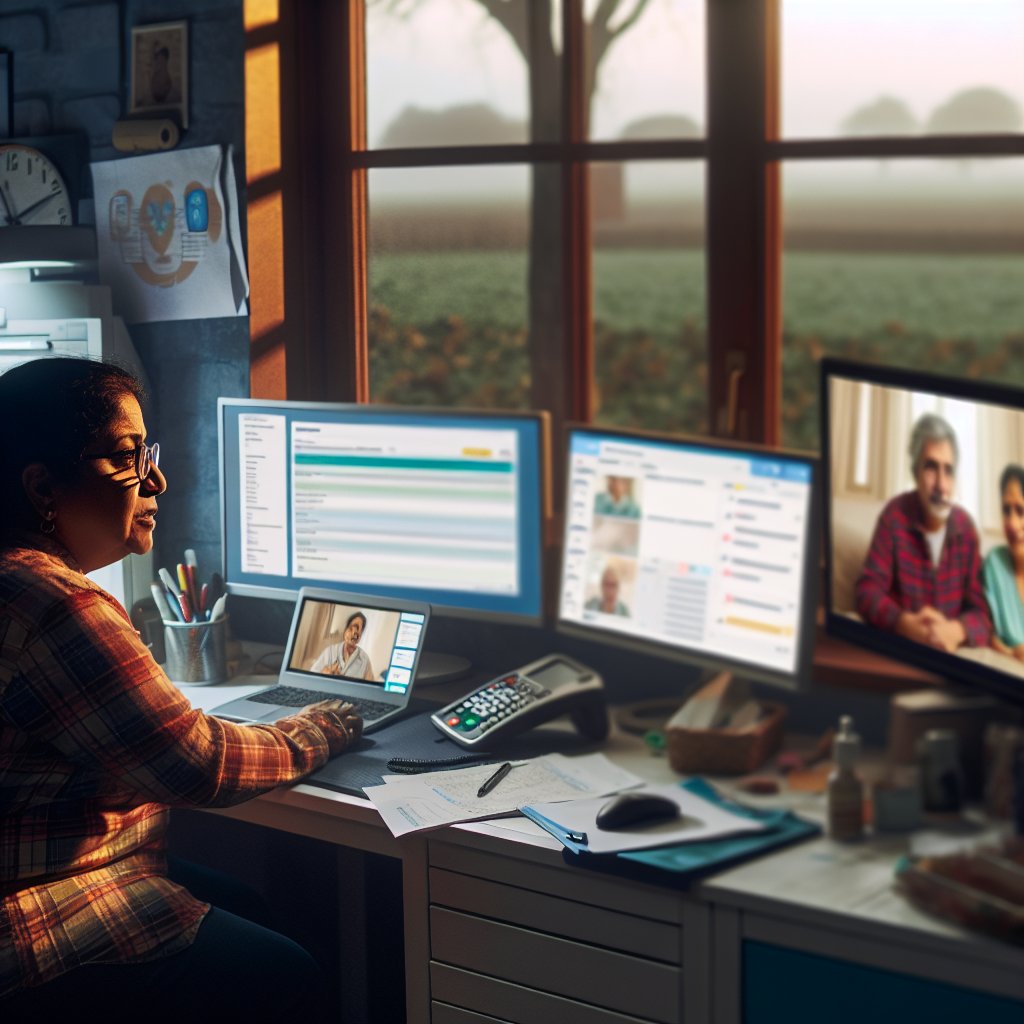Introduction to 5G Technology and its Role in Healthcare
Overview of 5G Technology
5G technology represents a significant advancement in mobile communication.
It provides faster data speeds and lower latency compared to previous networks.
This technology enhances connectivity, enabling real-time communication across devices.
Moreover, 5G supports a wide array of applications in various fields.
Impact on Healthcare Delivery
Healthcare delivery has improved remarkably with the introduction of 5G.
Remote health monitoring becomes feasible, particularly in rural areas.
Healthcare professionals can now access patient data instantly.
Patients benefit from timely interventions facilitated by improved connectivity.
Benefits for Rural Areas
Rural areas often lack access to specialized healthcare services.
5G technology bridges this gap by linking rural patients with specialists.
This connectivity encourages regular health check-ups and follow-ups.
Ultimately, it reduces the need for long-distance travel for medical care.
Examples of 5G Applications in Healthcare
One application includes remote patient monitoring systems.
These systems provide real-time data to healthcare providers.
Telemedicine services also expand access to medical consultations.
Furthermore, wearable devices track vital signs continuously.
Future Prospects of 5G in Healthcare
The future of healthcare is promising with expanded 5G capabilities.
New technologies will emerge, enhancing health management systems.
Healthcare will become more personalized and patient-centered.
As 5G networks expand, they will support innovative health solutions.
Overview of Remote Health Monitoring
Importance of Remote Health Monitoring
Remote health monitoring empowers healthcare access in rural areas.
It significantly reduces the need for patients to travel long distances.
This technology enhances patient engagement in their healthcare.
Moreover, it ensures timely medical intervention when necessary.
Patients can monitor chronic conditions from the comfort of home.
Consequently, this leads to better health outcomes and quality of life.
Benefits of Remote Health Monitoring
Remote health monitoring offers several key benefits.
- Firstly, it provides real-time health data to healthcare providers.
- Secondly, it enables faster response times during emergencies.
- Additionally, it reduces healthcare costs associated with traditional visits.
- Moreover, it encourages preventive care and healthy lifestyle choices.
- Finally, it expands access to specialized healthcare services.
These advantages are particularly valuable in underserved areas.
As a result, remote health monitoring fosters a more equitable healthcare system.
Challenges of Healthcare Access in Rural Areas
Geographical Isolation
Rural areas often experience significant geographical isolation.
This isolation limits access to healthcare facilities.
Patients may need to travel long distances for treatment.
Consequently, many individuals delay seeking necessary care.
Limited Healthcare Resources
Rural communities frequently face a shortage of healthcare providers.
This lack of professionals affects the quality of care available.
Put Your Tech Company on the Map!
Get featured on Nicholas Idoko’s Blog for just $50. Showcase your business, boost credibility, and reach a growing audience eager for tech solutions.
Publish NowFacilities may lack specialized services that urban hospitals offer.
As a result, patients may not receive timely interventions.
Economic Constraints
Healthcare costs can be a burden for rural populations.
Many individuals struggle with insurance coverage options.
This financial strain deters patients from seeking help.
Moreover, local economies often support fewer healthcare investments.
Cultural Barriers
Cultural attitudes toward health also impact rural healthcare access.
Some individuals may prefer traditional remedies over modern medicine.
Additionally, a stigma around mental health persists in many communities.
Consequently, individuals may avoid seeking necessary services.
Technological Limitations
Access to advanced medical technology is often limited in rural regions.
Many facilities cannot afford the latest diagnostic tools.
This limitation can delay proper diagnosis and treatment.
Furthermore, patients may not have reliable internet access for telehealth.
Health Disparities
Health disparities are prevalent in rural communities.
Chronic diseases often affect rural populations more severely.
Additionally, higher rates of poverty contribute to these disparities.
Systemic issues further exacerbate challenges in healthcare access.
Delve into the Subject: Digital Twin Technology in Personalized Patient Care
How 5G Technology Enhances Remote Health Monitoring Capabilities
Increased Connectivity and Speed
5G technology revolutionizes communication in healthcare.
It offers faster data transfer rates compared to previous networks.
This speed allows real-time monitoring of patients’ health metrics.
Consequently, healthcare providers can access patient data instantly.
This immediate access enhances decision-making during emergencies.
Improved Device Interoperability
5G enables diverse health monitoring devices to communicate effectively.
This connectivity allows seamless integration of wearables and sensors.
As a result, healthcare providers gain comprehensive patient insights.
Additionally, interoperability ensures continuity of care across systems.
Enhanced Remote Consultation
With 5G, telehealth services become more accessible to rural areas.
High-definition video consultations replace the need for in-person visits.
Patients can connect with specialists without traveling long distances.
This capability promotes timely medical advice for urgent health issues.
Low Latency for Critical Applications
5G technology significantly reduces latency in data transmission.
This low latency is critical for remote surgeries and diagnostics.
Surgeons can operate robotic instruments remotely with precision.
Put Your Tech Company on the Map!
Get featured on Nicholas Idoko’s Blog for just $50. Showcase your business, boost credibility, and reach a growing audience eager for tech solutions.
Publish NowThis advancement expands access to specialized surgeries in remote regions.
Real-time Analytics and Alerts
5G supports advanced analytics for monitoring patient health data.
Healthcare providers receive real-time alerts about anomalies.
This proactive approach prevents complications before they escalate.
Moreover, data analytics help in personalized treatment plans.
Explore Further: Voice-Activated Health Apps for Patient Engagement
Use Cases of 5G-Powered Health Monitoring Solutions in Rural Settings
Remote Patient Monitoring
Remote patient monitoring allows healthcare providers to track patients’ health indicators from afar.
5G technology enhances data transmission speed and reliability for real-time monitoring.
This solution is particularly beneficial for patients with chronic diseases, such as diabetes or hypertension.
In rural areas, patients often experience limited access to healthcare facilities.
Telehealth applications enable patients to consult with doctors without extensive travel.
For instance, Sarah, a diabetic patient in a rural community, uses a smart glucose monitor.
The monitor sends data to her healthcare provider, ensuring timely interventions.
Emergency Response Systems
5G-powered emergency response systems significantly improve rural healthcare outcomes.
Fast data transmission helps emergency medical services respond quickly to critical situations.
For example, Jason, a paramedic, receives real-time patient data en route to an emergency.
This data includes vital signs and medical history, enabling informed decision-making upon arrival.
Moreover, this capability helps optimize resource allocation in remote areas.
As a result, patients receive care faster, potentially saving lives.
Telemedicine Consultations
Telemedicine consultations bridge the gap between patients and healthcare professionals.
5G networks provide high-quality video conferencing capabilities for effective communication.
Patients can consult specialists from urban hospitals without leaving their communities.
This access significantly reduces wait times for appointments.
Furthermore, telemedicine fosters collaboration among healthcare providers across distances.
For instance, Dr. Emily, a cardiologist, reviews a patient’s condition with a local nurse via video call.
Health Data Analytics
5G facilitates the collection and analysis of vast amounts of health data.
Healthcare providers can monitor trends and make data-driven decisions for population health.
This capability is crucial for preventive care in rural populations.
Data analytics can identify health risks early and promote timely interventions.
Additionally, it empowers communities to adopt healthier lifestyles.
For instance, health organizations can offer targeted education programs based on analyzed data.
Smart Wearables Integration
Smart wearables play a significant role in health monitoring in rural areas.
5G enables seamless connectivity between wearables and healthcare systems.
Patients can receive alerts and notifications on their devices regarding their health status.
For example, Mark, a heart patient, uses a heart rate monitor that syncs with his doctor’s system.
Put Your Tech Company on the Map!
Get featured on Nicholas Idoko’s Blog for just $50. Showcase your business, boost credibility, and reach a growing audience eager for tech solutions.
Publish NowThis continuous monitoring ensures prompt medical advice if abnormalities arise.
Consequently, smart wearables encourage proactive management of health conditions.
Uncover the Details: IoT Integration for Smart Hospital Systems

Integration of IoT Devices for Real-Time Health Data Collection
Overview of IoT in Healthcare
The Internet of Things (IoT) revolutionizes healthcare delivery in rural areas.
It connects various devices to facilitate real-time health data collection.
This process enhances patient monitoring and timely interventions.
Benefits of Remote Health Monitoring
Remote health monitoring offers several advantages for rural communities.
Firstly, it reduces the need for long-distance travel to healthcare facilities.
Secondly, it allows healthcare providers to access real-time health data.
Consequently, timely decisions can be made to address health concerns.
Types of IoT Devices Used
Various IoT devices enhance remote health monitoring capabilities.
- Wearable health monitors track vital signs continuously.
- Smart pill dispensers remind patients to take their medications.
- Connected thermometers provide rapid temperature readings.
- Blood glucose monitors send data directly to healthcare providers.
Data Security Considerations
Data security remains a top priority in healthcare IoT applications.
Implementing robust encryption protects sensitive patient information.
Regular software updates ensure devices remain secure from threats.
Additionally, healthcare organizations must comply with regulations such as HIPAA.
Challenges in Implementation
Despite the benefits, challenges exist in implementing IoT in rural health settings.
Limited internet connectivity can hinder effective data transmission.
Moreover, technological literacy varies among patients and providers.
These barriers must be addressed to fully realize IoT’s potential.
Future of IoT in Rural Healthcare
The future of IoT in rural healthcare looks promising.
Innovations will continue to enhance device functionality and connectivity.
Ultimately, these advancements will improve health outcomes for rural populations.
With proper support and investment, remote health monitoring can transform rural healthcare delivery.
You Might Also Like: Healthcare Data Visualization Tools for Real-Time Monitoring
Data Privacy and Security Issues in Remote Health Monitoring
Importance of Data Privacy
Data privacy is crucial in remote health monitoring.
Patients share personal and sensitive information regularly.
Unauthorized access can lead to severe consequences.
For instance, identity theft and fraud may occur.
Thus, protecting patient data is a top priority.
Challenges in Ensuring Security
Remote health monitoring faces various security challenges.
Cyberattacks pose a significant threat to patient information.
For example, hackers may compromise medical devices.
This can result in data breaches and loss of sensitive information.
Additionally, weak passwords and inadequate encryption increase risks.
Regulatory Frameworks and Compliance
Governments implement regulations to protect health data.
Put Your Tech Company on the Map!
Get featured on Nicholas Idoko’s Blog for just $50. Showcase your business, boost credibility, and reach a growing audience eager for tech solutions.
Publish NowThe Health Insurance Portability and Accountability Act (HIPAA) in the U.S. provides guidelines.
Compliance with such regulations enhances data security.
Moreover, organizations must ensure they follow best practices.
Regular audits and assessments can help maintain compliance.
Technological Solutions for Enhanced Security
Technology plays a vital role in ensuring data security.
Advanced encryption methods safeguard patient information during transmission.
Moreover, multi-factor authentication adds an extra layer of protection.
Organizations can also utilize secure cloud storage solutions.
This minimizes the risk of data loss and unauthorized access.
Educating Patients on Security Practices
Patient education is essential for maintaining data privacy.
Healthcare providers should inform patients about security measures.
Moreover, patients must understand the importance of secure passwords.
Encouraging vigilance against phishing attempts is beneficial.
By being informed, patients can help protect their information.
Future Trends: The Potential Impact of 5G on Rural Healthcare Innovations
Enhanced Connectivity
5G technology enables robust and reliable connectivity in rural areas.
This improvement bridges the gap between urban and rural healthcare services.
With higher bandwidth, medical professionals can transmit essential data rapidly.
Remote consultations become more feasible and effective.
As a result, patients gain access to specialists without traveling long distances.
Real-time Health Monitoring
5G facilitates real-time health monitoring through wearable devices.
Patients can receive immediate feedback on their health conditions.
This capability significantly enhances chronic disease management.
For instance, diabetes patients can track blood sugar levels continuously.
Healthcare providers can intervene faster when needed.
Telemedicine Expansion
Telemedicine can thrive thanks to the high speed of 5G networks.
Healthcare systems can provide virtual visits, reducing the need for physical appointments.
Patients save time and money when accessing healthcare remotely.
This convenience encourages more patients to seek medical advice.
It leads to better health outcomes.
Integration of Artificial Intelligence
5G supports robust AI applications in healthcare settings.
For example, algorithms can analyze vast amounts of patient data quickly.
This analysis helps in predicting health trends and issues early.
Consequently, rural healthcare providers can personalize treatment plans effectively.
AI-driven tools can aid in decision-making, ensuring timely care delivery.
Improved Emergency Services
5G technology enhances emergency response capabilities in rural areas.
Put Your Tech Company on the Map!
Get featured on Nicholas Idoko’s Blog for just $50. Showcase your business, boost credibility, and reach a growing audience eager for tech solutions.
Publish NowEmergency personnel can share critical information instantly.
This connection allows for rapid assessment and decision-making during emergencies.
Moreover, location tracking becomes more accurate, guiding responders efficiently.
As a result, patient outcomes improve significantly during urgent situations.
Cost Reduction in Healthcare Delivery
5G can lower healthcare delivery costs in rural regions.
By reducing unnecessary travel for both patients and providers, savings accumulate.
Remote monitoring decreases hospital readmission rates, cutting expenses further.
Healthcare systems can allocate resources more effectively.
Ultimately, patients can benefit from affordable and accessible care.
Additional Resources
Innovations in Healthcare Using 5G Technology
Improving Healthcare Equity With Virtual Care Management
Before You Go…
Hey, thank you for reading this blog post to the end. I hope it was helpful. Let me tell you a little bit about Nicholas Idoko Technologies.
We help businesses and companies build an online presence by developing web, mobile, desktop, and blockchain applications.
We also help aspiring software developers and programmers learn the skills they need to have a successful career.
Take your first step to becoming a programming expert by joining our Learn To Code academy today!
Be sure to contact us if you need more information or have any questions! We are readily available.
[E-Books for Sale]
1,500 AI Applications for Next-Level Growth: Unleash the Potential for Wealth and Innovation
$5.38 • 1,500 AI Applications • 228 pages
Are you ready to tap into the power of Artificial Intelligence without the tech jargon and endless guesswork? This definitive e-book unlocks 1,500 real-world AI strategies that can help you.
See All 1,500 AI Applications of this E-Book
750 Lucrative Business Ideas: Your Ultimate Guide to Thriving in the U.S. Market
$49 • 750 Business Ideas • 109 pages
Unlock 750 profitable business ideas to transform your future. Discover the ultimate guide for aspiring entrepreneurs today!
See All 750 Business Ideas of this E-Book
500 Cutting-Edge Tech Startup Ideas for 2024 & 2025: Innovate, Create, Dominate
$19.99 • 500 Tech Startup Ideas • 62 pages
You will get inspired with 500 innovative tech startup ideas for 2024 and 2025, complete with concise descriptions to help you kickstart your entrepreneurial journey in AI, Blockchain, IoT, Fintech, and AR/VR.
We Design & Develop Websites, Android & iOS Apps
Looking to transform your digital presence? We specialize in creating stunning websites and powerful mobile apps for Android and iOS. Let us bring your vision to life with innovative, tailored solutions!
Get Started Today




